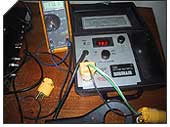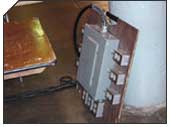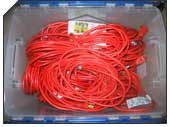| >> The quest for power ::::::::::::::::::::::::::::::::::::: by
hunter
> How to plan / diagram
There are many things that should be done to insure a good solid power
layout. We will highlight some of them here.
 First
up, after just looking around at how many plugs you see on the walls,
is a trip to power panels. The person showing you the
place should be able to point you to these. If they don't know
where they are at...errr ask where they keep the mops or what door
they never open. lol First
up, after just looking around at how many plugs you see on the walls,
is a trip to power panels. The person showing you the
place should be able to point you to these. If they don't know
where they are at...errr ask where they keep the mops or what door
they never open. lol
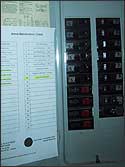 The panels above here are mains. You want to know how much they
are but the panels you are looking for have many small breakers in
them and a sheet that tells where they go like the one on the right
here. It is very important you effectively trace where each
circuit goes. If you can not read the sheet or actually even if
you can you should use a simple trick to track each one down. The panels above here are mains. You want to know how much they
are but the panels you are looking for have many small breakers in
them and a sheet that tells where they go like the one on the right
here. It is very important you effectively trace where each
circuit goes. If you can not read the sheet or actually even if
you can you should use a simple trick to track each one down.
Have one person go to each wall socket with a lamp or electric drill
or whatever electric appliance.
Another person goes to the panel (2 way radios or a third person comes
in handy here) and flips each breaker till the light goes out.
Mark the number of that breaker (indented into metal by breaker) on a
blueprint showing that wall socket. Repeat this till you have a
complete power map. Pain in the ass? Yeah but not as big
of a pain
as when people start coming at you with pitch forks cause they have no power
at their table!!
This map will come in handy for other things too. It will help you
decide how to lay out tables and once your party is cooking you will know exactly which breaker to flip
if a table goes down.
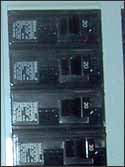 You
also want to know how much available power / circuits you have.
Look on the breakers themselves (see pic) and you will see a number.
Most commonly it is a 20. This indicates that circuit has a 20
amp breaker. Going back to our 80% rule, that means that
whatever is connected to that breaker (could be one wall socket or 2
or 3 or...) should* be able to power 5 computers. Do not make
the common mistake of assuming that each wall socket has its own full
20 amp breaker. States have different codes on how wall sockets
must be wired. When your done, you should know more about the
power then the person showing you around and almost as much as the
person who put it in. You
also want to know how much available power / circuits you have.
Look on the breakers themselves (see pic) and you will see a number.
Most commonly it is a 20. This indicates that circuit has a 20
amp breaker. Going back to our 80% rule, that means that
whatever is connected to that breaker (could be one wall socket or 2
or 3 or...) should* be able to power 5 computers. Do not make
the common mistake of assuming that each wall socket has its own full
20 amp breaker. States have different codes on how wall sockets
must be wired. When your done, you should know more about the
power then the person showing you around and almost as much as the
person who put it in.
> Shopping list
What you will need for power equipment depends on the size of party
and your financial situation.
The cheapest way is to lay out all of extension cords to the
appropriate tables and have guest (a) plug into that extension cord
with their power strip. Guest (a) now plugs their equipment into
their own power strip. Guests (b) and (c) plug their own power
strips into (a's) power strip and then plug their equipment
 into their
own strip.
DO NOT daisy chain them!!! This method keeps
everybody (except guest a) on their own strip so when they pack up to
leave they bring no one else down! It is a good idea to ask who
is going to stay the whole time to determine who (guest a) will be.
A word of warning, this method requires a lot of supervision. It
is real easy for people to start sharing strips, daisy chaining and
the like. That either ends up with the table going down or
someone pissed off cause they got unplugged. into their
own strip.
DO NOT daisy chain them!!! This method keeps
everybody (except guest a) on their own strip so when they pack up to
leave they bring no one else down! It is a good idea to ask who
is going to stay the whole time to determine who (guest a) will be.
A word of warning, this method requires a lot of supervision. It
is real easy for people to start sharing strips, daisy chaining and
the like. That either ends up with the table going down or
someone pissed off cause they got unplugged.
 The
preferred way is for you to have all power cords laid out with power
strips all ready attached and correctly taped off. Taped off?
Yeah, you want to tape off the receptacles that CAN NOT be used.
You determine how many get taped off by deciding how much that power
strip can hold (15amp usually) and / or how many amps you have
available on that circuit. You can see by our photo we have: The
preferred way is for you to have all power cords laid out with power
strips all ready attached and correctly taped off. Taped off?
Yeah, you want to tape off the receptacles that CAN NOT be used.
You determine how many get taped off by deciding how much that power
strip can hold (15amp usually) and / or how many amps you have
available on that circuit. You can see by our photo we have:
14ga / 15amp ext. cord, 1 to 3 way plug, 1 belkin with 3 open
receptacles and 1 with 2 open receptacles. Each guest plugs
their own power strip directly into one of these two belkins and then
their equipment into their own strip. Any of those guests can
now tear down without taking down anyone else. Further testing
may show we can safely get all 5 computers on one power strip, but we
like to error to the safe side cause we have been bit before!
Don't forget to tape over any wall receptacles and ext. cord ends that
are not to be used too. People have a tendency to take power
into their own hands and that usually ends in a table outage.
 As
I have already stated we use 14ga, 15 amp indoor / outdoor extension
cords. These can be had at almost any hardware or home
improvement store. They look at you real funny when you tell
them you need 60 of them though, but that is another story : )
Yes, 12ga cords would be better but the cost difference is quite a
bit. If you can afford them great. We have not had any
problems with the 14's, but we do feel the cords periodically to make
sure they are not getting warm. On shorter lengths it also As
I have already stated we use 14ga, 15 amp indoor / outdoor extension
cords. These can be had at almost any hardware or home
improvement store. They look at you real funny when you tell
them you need 60 of them though, but that is another story : )
Yes, 12ga cords would be better but the cost difference is quite a
bit. If you can afford them great. We have not had any
problems with the 14's, but we do feel the cords periodically to make
sure they are not getting warm. On shorter lengths it also
 doesn't
matter as much. We try to keep our cord lengths at 25' and 50'.
We do have some 100' cords but we try to use them last and sparingly.
Keep in mind that you lose some power based on length! This is
where the 12ga cords would come in handy cause you would lose less
over the same distance when compared with 14ga cords. Take
a good look at the the picture on the right. Your moms lamp cord
is NOT what you want to be using! doesn't
matter as much. We try to keep our cord lengths at 25' and 50'.
We do have some 100' cords but we try to use them last and sparingly.
Keep in mind that you lose some power based on length! This is
where the 12ga cords would come in handy cause you would lose less
over the same distance when compared with 14ga cords. Take
a good look at the the picture on the right. Your moms lamp cord
is NOT what you want to be using!
|



